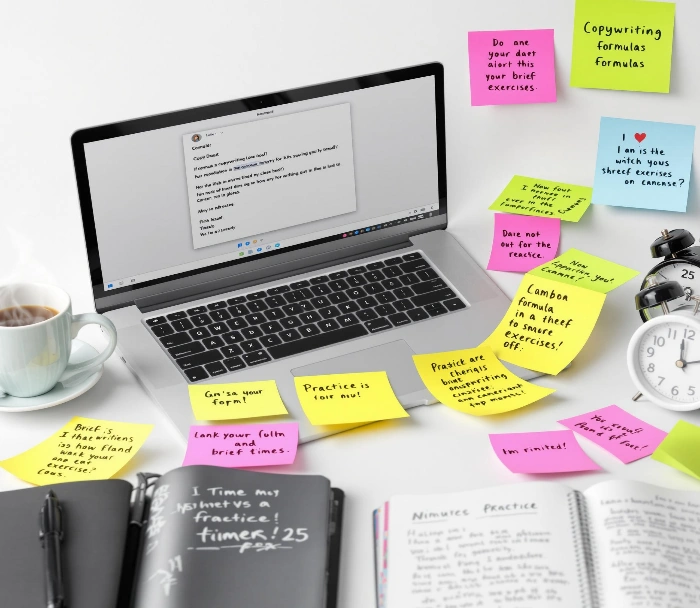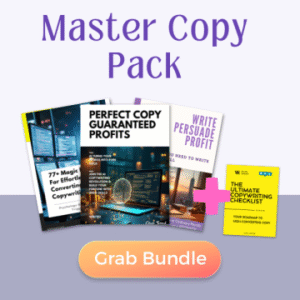Email copywriting exercises are essential tools for anyone looking to improve their marketing results. With inbox competition fiercer than ever, practicing these targeted drills can transform your messaging from ignored to irresistible. As a copywriting expert with over a decade of experience, I’ve collected the most effective exercises that consistently produce results for both beginners and veterans.
Why practice makes perfect in email copywriting
The difference between average and exceptional email copy isn’t talent – it’s training. Just like athletes condition their bodies, copywriters must train their creative muscles. Regular email copywriting exercises sharpen your skills in ways that reading theory simply cannot. Each practice session builds neural pathways that make compelling writing more automatic and natural.
The exercises in this guide follow a strategic progression. We start with warm-ups to overcome blank page paralysis. Then we tackle each email component sequentially: subject lines, opening hooks, body copy, and calls-to-action. The advanced sections cover testing and real-world application to ensure your skills translate into measurable results.
Recommended reading:
- Email copywriting earning: How to maximize your income
- Email copywriting training to crafting high-converting messages
- Email copywriting tools to crafting high-converting messages
- How to become an email copywriter: Roadmap for beginners
Quick-start warm-up exercises
Before crafting complete emails, these warm-up drills prime your creative engine. Spend just five minutes on each to build momentum.
1. The emotion evocation sprint
Pick one emotion (curiosity, fear, excitement, etc.) and write five different statements that trigger this feeling. Keep each under ten words. This exercise trains you to generate emotional responses with minimal text – crucial for subject lines and headers.
Example for curiosity:
- “The email trick nobody will tell you about”
- “What happens after you click send?”
- “This opens more emails than any other technique”
2. The benefit translation drill
Select a product feature and translate it into five different customer benefits. This exercise helps you shift from product-focused to customer-focused writing.
Example for “automated email scheduling”:
- “Sleep while your emails work for you”
- “Never miss prime engagement hours again”
- “Send messages when recipients are most likely to read”
3. The clarity challenge
Take a complex industry concept and explain it in progressively simpler terms, as if to a colleague, then a friend, then a child. This builds the valuable skill of making complicated ideas accessible.
Example for “email segmentation”:
- Colleague version: “Dynamic list filtering based on behavioral triggers and demographic data points”
- Friend version: “Sorting your email list into groups based on what people do and who they are”
- Child version: “Sending different messages to different people who like different things”
Subject line creation exercises
The subject line determines whether your email gets opened or ignored. These email copywriting exercises focus specifically on crafting irresistible first impressions.
4. The headline adaptation workshop
Find ten successful headlines from top publications or viral content. Transform each into an email subject line relevant to your product or service. This leverages proven attention-grabbing formats.
Example transformations:
- Magazine headline: “10 Hidden Vacation Spots Experts Don’t Want You to Know About”
- Email subject line: “7 Email Tactics Competitors Hope You Never Discover”
5. The urgent reframe practice
Take five ordinary announcements and rewrite them with varying degrees of urgency. This helps you create time sensitivity without sounding desperate or fake.
Example:
- Original: “New feature available”
- Reframes:
- “New feature available today only”
- “Access our new feature before it goes public”
- “Last chance: Try our exclusive feature before launch”
6. The curiosity gap builder
Create ten subject lines using the curiosity gap technique – provide enough information to spark interest but not enough to satisfy curiosity. This psychological trigger makes opens almost irresistible.
Examples:
- “This email mistake costs companies thousands”
- “The surprising reason subscribers ignore your messages”
- “What we discovered when we analyzed 10,000 emails”
Opening hook writing exercises
Once your subject line secures the open, your first few sentences must maintain engagement. These email copywriting exercises help craft compelling openers.
7. The pattern interrupt practice
Write five opening lines that challenge conventional wisdom or surprise the reader. This pattern interrupt technique prevents readers from mentally filtering out your message.
Examples:
- “Forget everything you know about email marketing.”
- “Most advice about email copywriting actually hurts your results.”
- “Your most successful competitor is NOT doing what the gurus suggest.”
8. The empathy elevator
Write opening paragraphs addressing the same pain point but at different empathy levels. Start with acknowledging the problem, then escalate to showing deep understanding of its emotional impact.
Example progression:
- Basic: “Email deliverability issues waste your time.”
- Better: “When emails bounce back, weeks of careful planning go down the drain.”
- Best: “That sinking feeling when you realize your important campaign never reached its targets – after you already reported projected results to your boss.”
9. The story starter sprint
Draft five different story beginnings you could use as email openers. Stories bypass logical resistance and engage readers on an emotional level.
Example:
- “Last Tuesday, I made a costly email mistake that taught me more than ten years of marketing experience.”
- “When client X came to us, they were sending 10,000 emails weekly with only 37 clicks to show for it.”
- “Three years ago, our team discovered an email approach that completely transformed our business model.”
Body copy crafting exercises
The body of your email delivers your core message and builds desire. These exercises strengthen your ability to maintain engagement and persuade effectively.
10. The feature-benefit connector
List ten features of your product or service. For each, write three different benefit statements that connect the feature to emotional or practical customer outcomes. This reinforces the crucial skill of selling benefits, not features.
Example:
- Feature: AI-powered email timing
- Benefits:
- “Send emails exactly when your recipient is most likely to read them.”
- “Stop wondering if your timing is causing low open rates.”
- “Match your message delivery to your customer’s natural email checking rhythm.”
11. The objection crusher
Identify five common objections to your offer. Write three different ways to address each objection preemptively within your email body. This anticipation makes your copy more persuasive.
Example objection: “This seems too complicated”
- Crusher #1: “Our step-by-step wizard makes implementation simple – even for non-technical team members.”
- Crusher #2: “Most users report successful setup within just 18 minutes.”
- Crusher #3: “We handle all technical aspects, so you can focus on results rather than implementation.”
12. The clarity scale edit
Write a paragraph about your offer, then edit it three times: first for an 8th-grade reading level, then for a 6th-grade level, then for a 4th-grade level. This develops the critical skill of simplification without losing meaning.
Example progression:
- Original: “Our proprietary algorithm analyzes multifactorial engagement metrics to determine optimal chronological deployment of communications.”
- 8th grade: “Our special system looks at when people engage with emails to figure out the best time to send your messages.”
- 6th grade: “Our tool finds out when people read emails most and sends your messages at that exact time.”
- 4th grade: “Our tool sends your emails when people are most likely to read them.”
Call-to-action development exercises
Even persuasive emails fail without strong calls-to-action. These email copywriting exercises focus on creating irresistible CTAs.
13. The action verb arsenal
Create a personal swipe file of 50 action verbs more compelling than “click” or “submit.” Then practice writing CTAs using these dynamic alternatives. This prevents bland, ineffective closing requests.
Examples:
- Instead of “Submit for your free trial”: “Unlock your free trial now”
- Instead of “Click to learn more”: “Discover the complete system today”
- Instead of “Sign up for updates”: “Join the insiders circle instantly”
14. The value reinforcement finisher
Practice writing CTAs that reinforce the core value proposition rather than just requesting action. This reminds readers why they should respond right before decision time.
Examples:
- Instead of “Book a call”: “Secure your strategy session while spots remain”
- Instead of “Download now”: “Get instant access to time-saving templates”
- Instead of “Buy today”: “Start reducing email creation time today”
15. The urgency balance trainer
Write five CTAs with increasing urgency levels without crossing into desperation territory. This builds the skill of creating genuine time sensitivity.
Example progression:
- Mild: “See if seats are still available”
- Medium: “Reserve your spot while registration remains open”
- Stronger: “Claim one of the 15 remaining access passes”
- Urgent: “Last call: Registration closes at midnight”
- Very urgent: “Final opportunity: Only 3 spots left as of 2PM”
A/B testing exercises for continuous improvement
Ongoing optimization separates amateur copywriters from professionals. These exercises develop your testing muscle.
The controlled variation challenge
Take one complete email and create five different versions changing only one element each time. This builds the discipline to test systematically rather than randomly.
Test elements to vary:
- Subject line only
- Opening paragraph only
- Body format (bullets versus paragraphs)
- Call-to-action wording only
- Call-to-action button color only
The radical reinvention test
Take your best-performing email and create a completely different version using an alternative approach. This prevents getting stuck in local maximums of performance.
Reinvention examples:
- Switch from problem-solution to story-based structure
- Change from feature focus to customer case study
- Transform from text-heavy to visual with minimal text
Real-world application exercises
Theory becomes valuable when applied. These email copywriting exercises bridge practice and performance.
The swipe file building habit
Commit to collecting five remarkable emails weekly. Analyze why each works and extract templates you can adapt. This ongoing practice builds your personal cookbook of proven approaches.
Create swipe categories like:
- Abandoned cart recovery emails
- Webinar invitations
- Customer win-back campaigns
- New product announcements
- Upsell sequences
The cross-industry adaptation challenge
Find successful emails from completely different industries and adapt their approaches to your field. This exercise prevents industry tunnel vision and generates fresh ideas.
Example adaptations:
- Restaurant reservation reminder → Software trial expiration reminder
- Fashion new collection announcement → New feature launch
- Hotel loyalty program → SaaS user rewards program
Implementing your email copywriting exercises
Consistent practice yields consistent growth. Create a personal training schedule incorporating these email copywriting exercises into your routine. Even just fifteen minutes daily produces remarkable improvement over weeks and months.
Start with the fundamentals: warm-ups, subject lines, and opening hooks. Once those strengthen, progress to body copy and CTA exercises. Advanced copywriters should focus more time on testing and real-world applications.
Track your progress by saving dated examples of your work. Review monthly to observe your evolution. Many copywriters report significant improvement visible within just 30 days of regular practice.
Remember that email copywriting exercises work best when applied to actual campaigns. After practice sessions, immediately incorporate your strongest new approaches into current projects. This reinforces learning and delivers immediate business value.
The most successful email marketers aren’t naturally gifted writers – they’re disciplined practitioners who consistently sharpen their skills. By integrating these fifteen exercises into your professional development, you’ll join their ranks and watch your response rates climb accordingly.
Which email copywriting exercise will you start with today?

